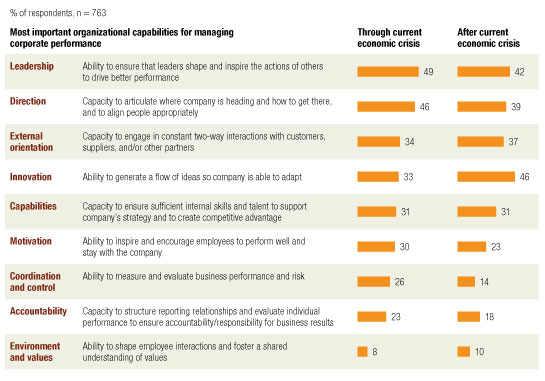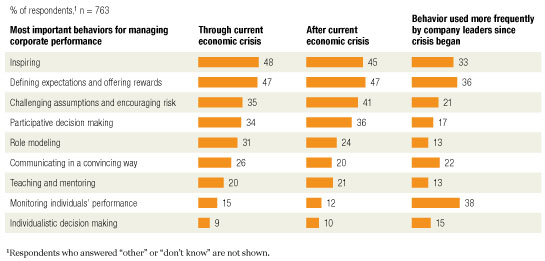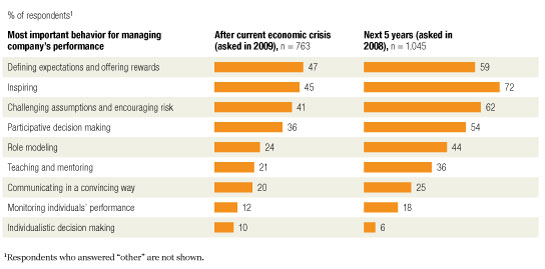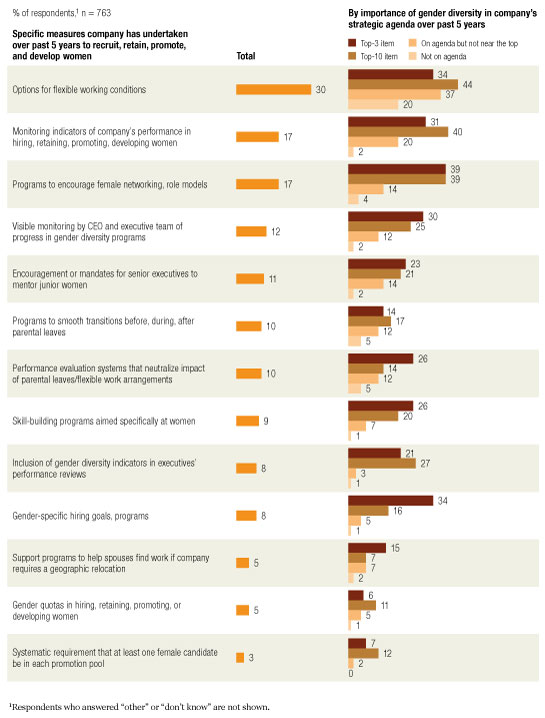A new survey investigates how individual leaders lead and how that has changed in the past year.1 For example, respondents say that during the crisis they have seen far more leaders focus on monitoring individual performance—even though they see that as one of the least helpful ways of managing the crisis. The survey also asked about the organizational capabilities and leadership behavior organizations will need to thrive during the recovery and about the ways companies are approaching employee development and gender diversity in the crisis.
The kinds of leadership behavior that executives say will most help their companies through the current crisis, such as inspiring others and defining expectations and rewards, are the same ones they say will help their companies thrive in the future. The executives’ assessment of what’s needed for the long term hasn’t changed over the past year. It is notable that these kinds of leadership behavior are the ones most used by women, who also have the greatest influence on many of the organizational capabilities executives agree are important for companies now and in the future, such as having inspiring leaders and a clear direction for companies. In that context, it’s good news that a majority of the respondents say their companies have not cut back on programs to recruit, retain, and develop women. However, this news is tempered by the finding that only a third of the respondents consider gender diversity to be among their companies’ top ten priorities and that relatively few are taking any specific actions to promote it.
Corporate capabilities
When asked which capabilities of organizations as a whole are most important for managing companies through the crisis, respondents choose two more often than any others: leadership, so that leaders inspire others and shape their actions, and direction, so that it’s clear where companies are going and that people are aligned on how to get there (Exhibit 1). Respondents also say those two capabilities have become more important since the crisis began. In contrast, nearly a third say that the capability of shaping the overall corporate environment and ensuring shared values has become less important.
When respondents look ahead to the period after the crisis, leadership and clear direction remain among the most important capabilities for managing performance (chosen by 42 percent and 39 percent of respondents, respectively). Although only a third of the respondents rate innovation as the most important capability for managing through the current crisis, 46 percent consider it the most important one afterward. This focus on innovation as an important factor for corporate performance after the crisis is consistent with findings in other McKinsey surveys.2
Leadership now, innovation later

Leading now and in the future
Executives say the two most critical kinds of individual leadership behavior for managing through the crisis are presenting an inspiring vision, cited by 48 percent, and defining expectations and rewarding achievement, close behind, at 47 percent (Exhibit 2). These two are among the three that more executives have seen increase in use during the crisis than any others. However, the third and most frequently adopted one is monitoring individual performance and taking corrective action—even though that is perceived as among the least relevant for managing through the current crisis and afterward.
Looking beyond the crisis, when we asked executives which kinds of behavior by individual leaders will be most important for managing their companies then, respondents selected the same ones that are important now: presenting an inspiring vision and defining expectations and rewarding achievement. Further, these results are similar to the answers to a similar question asked in July 2008, before the global economic crisis began: the top four are the same, though in a different order (Exhibit 3).
Another important leadership behavior for the future—challenging assumptions and encouraging risk taking and creativity—is not particularly prevalent today. However, other research has shown that this kind of leadership is likely to reinforce innovation, the organizational capability seen as most important after the crisis.3
Wanted: Inspirational leaders, clear standards

Similar needs for future leadership

Women matter
The behavior executives see as most helpful for managing performance through and after the crisis—inspiration and defining expectations and rewards—has been shown by a previous McKinsey study to be used more often by female leaders. Our own and other research has shown that women leaders are significantly likelier than men to define expectations and rewards and a bit likelier to be inspirational.4
Leadership and direction are seen as the most important capabilities through the crisis and are two of the top three cited as most important for the long term. Similarly, they are the two most positively influenced by having three or more women on a corporate board, our other work shows.5
Developing female leaders
However, the results suggest that many companies have not developed robust programs to support and increase gender diversity. Indeed, only 28 percent of the respondents say gender diversity has been a top-ten agenda item in their companies over the past five years, and 40 percent say it is not on their companies’ agendas at all. The good news is that for the vast majority—including those where gender diversity is near the top of their agendas—the crisis hasn’t changed its priority. Further, two-thirds of the respondents say the crisis has not changed the programs their companies have in place to recruit, retain, promote, and develop women, while only 37 percent say the same for programs to retain, promote, and develop all employees.
Flexible working conditions are the single most frequently chosen action companies take in support of gender diversity, but even so, only 30 percent of the respondents say their companies have such a program (Exhibit 4). Companies where gender diversity is a higher priority are likelier to be taking more measures. However, even where gender diversity is a top-three agenda item, only a third of the respondents say their companies have gender-specific hiring goals and programs. Just a quarter say they have performance evaluation systems that neutralize the effects of parental leaves or flexible work arrangements.
No clear strategy to promote gender diversity

Finally, just over 60 percent of all respondents say they believe that companies with diverse leadership teams including significant numbers of women generate higher financial returns—a bottom-line impact that has been shown in previous research by McKinsey and others.6 Nonetheless, 40 percent of the executives aren’t convinced, though more of them say that they simply don’t know than that they don’t believe there is such an impact. C-level executives are no more likely than executives overall to be unconvinced—41 percent don’t know if there is a link between diverse leadership and higher returns or don’t believe that there is. Male respondents, however, seem harder to convince, with just over half seeing a link between gender diversity and the bottom line.
Looking ahead
-
Companies could benefit from encouraging more executives to adopt the kinds of leadership behavior that executives believe are important to managing corporate performance through the crisis and afterward.
-
Looking beyond the crisis, companies would also do well to develop the kinds of leadership behavior that support innovation, such as challenging assumptions and encouraging risk taking and creativity.
-
Given the stronger performance associated with diverse leadership teams that include women, and the relatively low priority most companies put on gender diversity, many companies have a chance to improve their performance by paying more attention to this issue. The effort is particularly likely to improve performance because the leadership behavior and most of the organizational capabilities that all executives agree are important for companies to thrive in the long term are those most used or most influenced by women.

